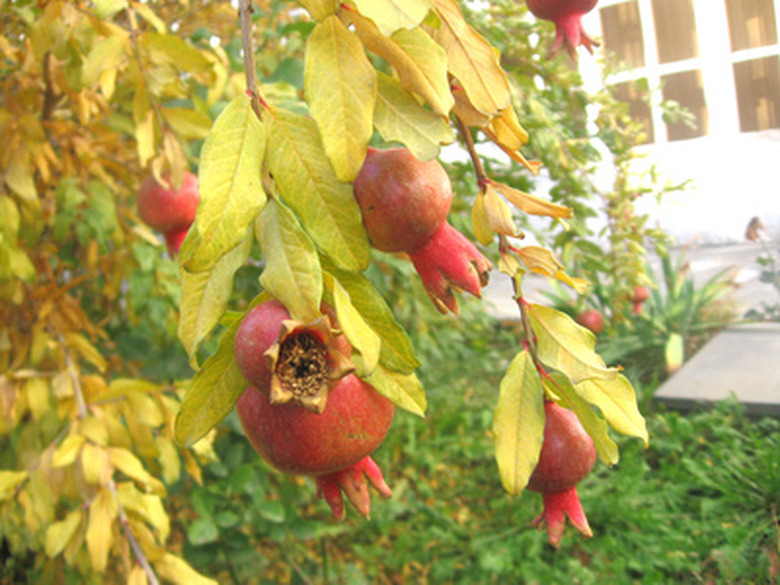What Kind Of Climate Does A Pomegranate Tree Need?
The pomegranate tree is a versatile plant that grows in regions with varying climates. With minimum temperatures and preferences for successful growth, identify the cultural requirements like sun exposure and the particular temperature and moisture ranges the pomegranate tree is capable of thriving in. Though the tree may grow, it will only produce its sweet and tart fruit in ideal environments.
Description and Climatic History
The pomegranate tree (Punica granatum L.) is considered a large shrub or small tree, reaching 20 to 30 feet tall. Displaying clustered flowers in red and white, the tree is prized for its flavorful deep pink to red fruit with edible sacs within. The pomegranate tree is native to the climates of the Himalayas, Iran and Northern India. More modern cultivation includes heavy planting regions in China, Egypt, Afghanistan, Pakistan, Bangladesh, Iran, Iraq, Burma and Saudi Arabia. Often found in Bermuda where it has become naturalized with planting beginning in 1621, the pomegranate tree is grown in a variety of climates from dry areas like Arizona to cool temperatures of Honduras, according to Purdue Horticulture.
- The pomegranate tree is a versatile plant that grows in regions with varying climates.
- Often found in Bermuda where it has become naturalized with planting beginning in 1621, the pomegranate tree is grown in a variety of climates from dry areas like Arizona to cool temperatures of Honduras, according to Purdue Horticulture.
Climate Basics
Pomegranate trees will grow successfully in tropical climates to warm temperate climates, according to the University of Florida IFAS Extension. The ideal climatic experience for a pomegranate tree includes summers with hot, dry days and winters with cool weather. Because the pomegranate tree can withstand hot weather and is cold hardy, gardeners can plant this tree in a variety of regions.
Specific Climate Requirements
Though versatile, there are particular requirements that mean the vigorous growth of the pomegranate tree or a weak, unhealthy cultivation. Though the pomegranate tree is more cold hardy than citrus fruit, according to the University of Florida IFAS Extension, it is still susceptible to injury from cold temperatures. With variable success in frost, temperatures that dip down to 10 degrees F can cause significant damage to pomegranate trees. In the United States, these trees are cold hardy to USDA Hardiness Zones 8 to 10 without damage, according to the Clemson University Extension.
- Pomegranate trees will grow successfully in tropical climates to warm temperate climates, according to the University of Florida IFAS Extension.
- Though the pomegranate tree is more cold hardy than citrus fruit, according to the University of Florida IFAS Extension, it is still susceptible to injury from cold temperatures.
Local Climate and Culture
Growing your pomegranate tree in the correct region is the first step toward a healthy tree, but your plant must be properly maintained and allowed appropriate cultural care for thorough success. Pomegranate trees thrive in full sun exposure but will still flower in partial shade; keep your tree out of heavily shaded areas. With a preference for well-drained soil with a pH of 5.5. to 7.0, you can maintain moisture levels with a 2- to 3-inch layer of organic mulch. Though drought-tolerant once established, consistently moist soil prevents fruit drop, notes Clemson University Extension.
Problems
When kept in proper climates, pomegranate trees are sturdy plants that suffer from few problems. If kept in poor conditions or neglected, pomegranate trees may suffer from lack of fruit set often due to a need for more sun exposure. Areas with excessively high humidity may result in incidence of leaf or fruit spots caused by a fungal infection. Additionally, weakened trees are susceptible to infestation by the insect pest called scale mites. If these problems occur, revise your maintenance method, apply three treatments of a neutral copper fungicide annually if leaf or fruit spot becomes a problem or for mites, apply sulfur dust in the beginning of June, advises University of Florida IFAS Extension.
- Growing your pomegranate tree in the correct region is the first step toward a healthy tree, but your plant must be properly maintained and allowed appropriate cultural care for thorough success.
- If kept in poor conditions or neglected, pomegranate trees may suffer from lack of fruit set often due to a need for more sun exposure.
